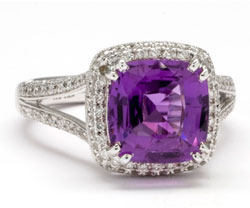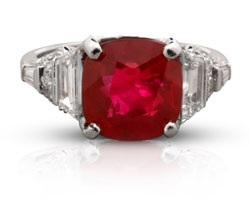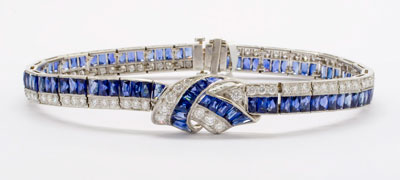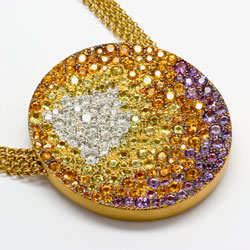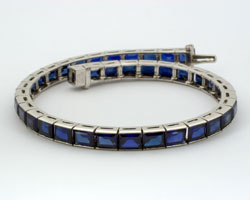The Corundum Spectrum

Gem corundum—ruby and sapphire—used to be a fairly rare and comparatively high-priced colored gem. Today corundum accounts for about one-third of the colored gem sales in the world, and its prices are all over the map.
Gem corundum occurs in a wide range of colors—red, yellow, green, purple, blue, pink, orange, brown, etc. Red corundum is called ruby; all other colors are sapphire.
Politics, technology, fashion, media, ethics, international trade, environmental concerns, the global recession all play their roles in corundum’s story. All go into affecting the gem’s value in the marketplace and therefore its valuation on a jewelry schedule.
Ruby and sapphire have been appreciated for thousands of years as rare and precious gems. They’ve become remarkably less rare since the 1980s, when technicians developed heat treatments that turned previously worthless corundum into attractive gems. Gem cutters and dealers began heat-treating low-quality corundum in large quantities and eventually were able to produce attractive sapphire and ruby for very low prices.
Their success increased demand. Mines that had been exhausted of high-grade corundum could now be mined for gem rough that was “treatable.” In fact, most ruby and sapphire mined today requires treatment to be salable at all. Natural untreated ruby and sapphire are increasingly rare and their prices are high.

Sapphire jewelry from Amazon.com for under $15.
Soon TV shopping channels and the internet entered the scene. These became the perfect outlets for reaching potential buyers of low- and mid-priced jewelry. Many jewelers will not carry gems of low quality, but on the net there are numerous sites that specialize in low-priced jewelry with treated, or enhanced, gems, often accompanied by grossly inflated appraisals.
Some of the Best
Colored gemstones (unlike diamonds) acquire a characteristic appearance based on the locale where they were mined. The conditions under which the gems grew, other minerals they encountered, leave visible traces that can profoundly affect their beauty, and therefore their price.
Kashmir Sapphire
Classic Kashmir sapphire is world-renowned for its distinctive velvety blue color, and the gem is priced accordingly. While sapphire is still mined in Kashmir, it’s not the same quality as before. The highest quality stones are now found only in older jewelry offered at high-end resale venues such as auctions. However, even heat-treated Kashmir sapphire commands a high price, though some experts say price should be based on a stone’s beauty rather than merely on its source.
Burmese Ruby
Burma (Myanmar) has been a source of fine ruby for a millennium. “Burmese ruby” traditionally refers to the vivid red corundum mined in the Mogok region. Rubies from this area still command a high price, and prices have climbed significantly because of the U.S. ban on importing gems from Myanmar.
Since the 1990s large deposits of lower-quality ruby have been mined in the Mong Hsu area of Burma. These rubies typically have cavities and fissures that are usually filled with glass during the heating process to make them look better. Here, again, the source country isn’t an absolute indicator of quality. A Burmese ruby should also be identified as Magok or Mong Hsu—and any treatments should be disclosed.
Padparadscha
Ceylon (Sri Lanka is) the original source of the rare pinkish orange sapphire called padparadscha. Supplies of this gem (natural and untreated) have greatly diminished in recent years, resulting in dramatic price increases worldwide. The market has also had to deal with fraudulent padparadscha (see below).
A “Wild West” Industry
The competitive world of the gem industry often has a “Wild West” character to it. As new sources are discovered, dealers and workers rush to that mine. Sometimes the gem deposit is rich but is soon exhausted; sometimes there is a large quantity to be mined, but the quality is poor; sometimes the quality is decent, but only for very small gemstones.
A rich deposit can become a vital part of the region’s economy, both for the local people and for the government. In areas of political unrest, insurgents may take control of this important financial resource. The players may change and the investment may shift focus as circumstances dictate.
A ruby story
A ruby deposit in Madagascar, in a remote rainforest location, created a boomtown almost overnight. An estimated 40,000 miners descended on the previously uninhabited locale. The gem material was plentiful, but most of the rough was fractured and considered unmarketable.
Four years later, large quantities of glass-filled ruby began entering the market. These rubies proved to be gems from that deposit, filled with lead glass to disguise their fractures. As time went on, the deposit yielded poorer and poorer material. Eventually, rubies from that site were more glass filler than actual corundum.
Fracture-filled rubies may look good to the naked eye—but glass is not ruby, and the value of the filled stone is immensely lower. Gems with fractures can easily break or chip. Also, when the filling breaks down, the “gem” can fall to pieces. Breakdown of a fracture-filling treatment is not damage for which the insurer is liable.
A sapphire story
Centers of gem production and trade keep changing. In the 1930s, Thailand was producing about half the world’s sapphires; 60 years later, most of its known deposits were played out. Local industry then moved aggressively from gem production to gem treatment and distribution. Today Thailand is the world center for cutting, trading and treating corundum. About 70% of the world’s sapphires and 90% of its rubies pass through that country.
Given the importance of gem trade in Thailand, that country also does a brisk business in selling gems to tourists. Vacationers are easy prey for retailers hawking “bargain” gems and jewelry. The Thai sapphire scam has been going strong for years.
Be wary of insuring gems or jewelry bought anywhere on vacation. Such jewelry should be appraised as soon as possible by a reliable jeweler/appraiser who is not connected with the seller.
Story of a “look-alike”
Because of the high stakes in the world gem market, there is strong incentive to manipulate and imitate qualities that affect a gem’s value: its quality and rarity.
Padparadscha is a rare pink-orange corundum originally mined in Ceylon (Sri Lanka). In 2001 padparadscha-like sapphires, purportedly from East Africa, began appearing on the market. Dealers suspected a new gem treatment. The treatment was difficult to detect, and for a period of time all padparadscha became suspect. Prices fell quickly and some wholesalers lost tens of millions of dollars.
Ultimately, thousands of the treated stones were sold—without disclosure. They were worth only a fraction of the value they were given.
Dealers who are victimized may, knowingly or unknowingly, pass on their losses to less knowledgeable jewelers. The jewelers, in turn, overcharge consumers. Consumers who realize they’ve been burned may then try to “sell” the jewelry to the insurer through a bogus claim.
Losses from such grossly overpriced gems could be passed on to the insurer unless you secure an appraisal from a knowledgeable independent appraiser, preferably a graduate gemologist who is also a Certified Insurance Appraiser™.
These few examples from the world of ruby and sapphire also point out the importance of regular appraisal valuation updates. When fraud threatens the gem market, when an important mine runs dry, when new gem treatments are discovered, when environmental restrictions raise mining costs, or even just when fashions change, the value of a gem can rise or fall dramatically.
FOR AGENTS & UNDERWRITERS
For rubies and sapphires, it is essential that the appraisal be written by a gemologist experienced with colored gemstones and familiar with the current pricing, treatments and frauds. Most jewelers deal primarily with diamonds, and even a trained gemologist may have little experience with colored stones.
High-value Kashmir, Burma and Ceylon rubies and sapphires should be accompanied by a report from a reliable lab (such as AGL or Gübelin) verifying origin. (The insured can take the jewelry to his or her own jeweler, who will send it to a lab that has the equipment and expertise to determine gem origin.)
Synthetic sapphires are quite common. The appraisal should state that the gem is either natural or synthetic, since synthetic gems are worth considerably less than natural.
For sapphire, all treatments other than heating should be disclosed on the appraisal. (Heat treatment may also be listed, but sapphire is assumed to be heat-treated unless the appraisal specifies it has not been.)
If a gem is not treated, that should be specifically stated on the appraisal. A treated stone has only a fraction of the value of an untreated gem of similar appearance.
Check the appraisal for specific information on tone, saturation and hue. These are most important in determining the value of colored gemstones. It is useless to describe a ruby’s color as simply “red”, for example, since rubies are by definition red. In fact, gemologists recognize 4 distinct red hues for ruby.
For jewelry valued at $25,000 or more, get a second appraisal. Be sure the appraiser is experienced in dealing with colored gemstones.
FOR ADJUSTERS
In damage claims, have the jewelry examined by a jewelry professional working on your behalf to verify the jewelry’s quality and the truth of the appraisal. He might find, for example, that the stone was treated and the treatment broke down (damage for which the insurer is not liable).
Be sure the jeweler examining a damaged stone or pricing a replacement has experience in dealing with colored stones. He should also be a graduate gemologist and, ideally, also a Certified Insurance Appraiser™ (specifically trained in appraising jewelry for insurance).
For loss claims, carefully read the appraisal for mention of such terms as treatment, clarity enhancement, fracture filling, bulk diffusion, or beryllium diffused. These would suggest a lower-quality treated stone, perhaps with a significantly lower valuation than listed on the appraisal.
Do not assume that if the appraisal doesn't mention treatments, the gem must be untreated; most likely, if treatment (or lack of it) is not mentioned, other information is incomplete as well.
Synthetic sapphires are worth much less than natural. Check the appraisal for words such as synthetic, lab-grown, cultured or manufactured. The term "Lindy" or "Linde" describes a star sapphire that is synthetic.
While there are fewer claims on colored stones than on diamonds, colored stones usually have much higher markups and generally have inflated valuations. A typical one-carat (treated) sapphire, for example, has a replacement cost of $200-$300.
©2000-2025, JCRS Inland Marine Solutions, Inc. All Rights Reserved. www.jcrs.com

